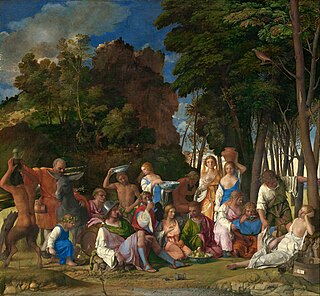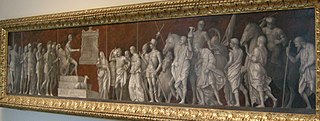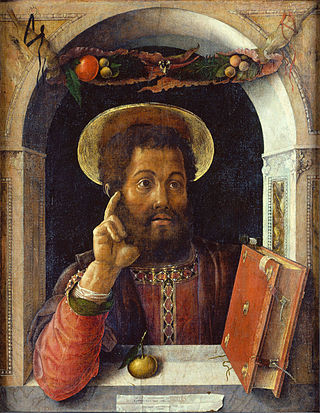
Jacopo Bellini was one of the founders of the Renaissance style of painting in Venice and northern Italy. His sons Gentile and Giovanni Bellini, and his son-in-law Andrea Mantegna, were also famous painters.

Andrea Mantegna was an Italian painter, a student of Roman archeology, and son-in-law of Jacopo Bellini.

William Thomas Beckford was an English novelist, art critic, planter and politician. He was reputed at one stage to be England's richest commoner. The son of William Beckford and Maria Hamilton, daughter of the Hon. George Hamilton, he served as a Member of Parliament for Wells in 1784–1790 and Hindon in 1790–1795 and 1806–1820. Beckford is best known for writing the 1786 Gothic novel Vathek, for building the Fonthill Abbey in Wiltshire and Beckford's Tower in Bath, and for his extensive art collection.

Sophonisba was a Carthaginian noblewoman who lived during the Second Punic War, and the daughter of Hasdrubal Gisco. She held influence over the Numidian political landscape, convincing king Syphax to change sides during the war, and later, in an act that became legendary, she poisoned herself rather than be humiliated in a Roman triumph.

The Triumphs of Caesar are a series of nine large paintings created by the Italian Renaissance artist Andrea Mantegna between 1484 and 1492 for the Gonzaga Ducal Palace, Mantua. They depict a triumphal military parade celebrating the victory of Julius Caesar in the Gallic Wars. Acknowledged from the time of Mantegna as his greatest masterpiece, they remain the most complete pictorial representation of a Roman triumph ever attempted and together they form the world's largest metric area of Italian Renaissance paintings outside Italy.

The Adoration of the Magi or Uffizi Triptych is a group of three tempera-on-panel paintings by Andrea Mantegna, dating to around 1460. Their three subjects are the Ascension of Christ, Adoration of the Magi the largest and central panel and the Circumcision of Christ. They were gathered as a trio in the 19th century, although some art historians doubt that they were created as a triptych set as they are arranged. They are in the Uffizi Gallery in Florence.

The Feast of the Gods is an oil painting by the Italian Renaissance master Giovanni Bellini, with substantial additions in stages to the left and center landscape by Dosso Dossi and Titian. It is one of the few mythological pictures by the Venetian artist. Completed in 1514, it was his last major work. It is now in the National Gallery of Art in Washington D.C., which calls it "one of the greatest Renaissance paintings in the United States".

Francesco Bonsignori, also known as Francesco Monsignori, was an Italian painter and draughtsman, characterized by his excellence in religious subjects, portraits, architectural perspective and animals. He was born in Verona and died in Caldiero, a city near Verona. Bonsignori's style in early period was under the influence of his teacher Liberale da Verona. After becoming the portraitist and court artist to the Gonzaga family of Mantua in 1487, his style was influenced by Andrea Mantegna, who also worked for Francesco Gonzaga from the 1480s. They collaborated to execute several religious paintings, mainly with the theme of Madonna and Child. The attribution of theportrait of a Venetian Senator was debatable until the last century because of the similarity in techniques used by Bonsignori and his teacher Mantegna. During the phase of his career in Mantua, there is an undocumented period between 1495 and July 1506 with no official record regarding his activities by the court of Mantua. Bonsignori's late style was decisively influenced by Lorenzo Costa in terms of form and color. He produced his last monumental altarpiece the Adoration of the Blessed Osanna Andreasi in 1519 shortly before his death.

The Adoration of the Shepherds is a painting by the northern Italian Renaissance artist Andrea Mantegna, dated to c. 1450-1451.

Judith with the Head of Holofernes is an Italian Renaissance painting attributed to Andrea Mantegna or to a follower of his, possibly Giulio Campagnola. Painted in tempera in around 1495 or 1500, it depicts the common artistic subject of Judith beheading Holofernes.

The Battle Between Love and Chastity is a painting by the Italian Renaissance artist Pietro Perugino, now in the Musée du Louvre, in Paris, France. It was originally commissioned for the studiolo (cabinet) of Isabella d'Este, Marchesa of Mantua, in the Castello di San Giorgio.

St Jerome in the Wilderness is a tempera on panel painting, measuring 48 by 36 cm and attributed to Andrea Mantegna. It dates to between 1449 and 1450 and is now in the São Paulo Museum of Art.

The Madonna of the Caves is a tempera on panel painting measuring 32 cm 29.6 cm. It was painted in 1488-1490 by the Italian painter Andrea Mantegna and is now in the Uffizi Gallery in Florence.
The Introduction of the Cult of Cybele at Rome is a painting in glue tempera on canvas by Andrea Mantegna. Measuring 73.5 cm by 268 cm, It was produced in 1505–1506 and is now in the National Gallery in London. Like much of Mantegna's output after 1495 it is in monochrome, linked to contemporary sculpture and also part of the trend for illusion and trompe-l'œil favoured by the Mantuan court and especially by Isabella d'Este.

The Continence of Scipio or An Episode from the Life of Publius Cornelius Scipio is a painting in oils on canvas by the Italian Renaissance artist Giovanni Bellini, dating to 1507–08 and now in the National Gallery of Art in Washington, D.C.
The Studiolo of Isabella d'Este was a special private study, first in castello di San Giorgio, later the Studiolo was moved to the Corte Vecchi apartments in the Ducal Palace in Mantua, designed by, and with a collection of art specially commissioned by Isabella d'Este.

Saint Mark is a 1448 tempera on canvas painting by Andrea Mantegna. It is now in the Städel Museum in Frankfurt. It is the earliest known work by the artist. The painting depicts Mark the Evangelist.

Judith with the Head of Holofernes is a c. 1495 glue tempera on canvas painting by Andrea Mantegna, now in the National Gallery of Ireland in Dublin. It is in the grisaille style.

Lamentation of Christ is an oil painting created by Greek painter Nikolaos Kantounis. He was a painter and teacher. He was a priest. His teachers were famous painters Ioannis Korais and Nikolaos Koutouzis He was a representative of the Heptanese School. His artwork was created during the Neoclassical and Romantic periods in Greek art. He was active on the island of Zakynthos from 1782–1834. He was one of the earliest members of the modern Greek art period. Over 164 of his paintings have survived. He is known for painting many portraits. He was a member of the secret organization for Greek Independence called the Filiki Eteria. Towards the end of his life he was honored with the rank of Grand Sakellarios.




















